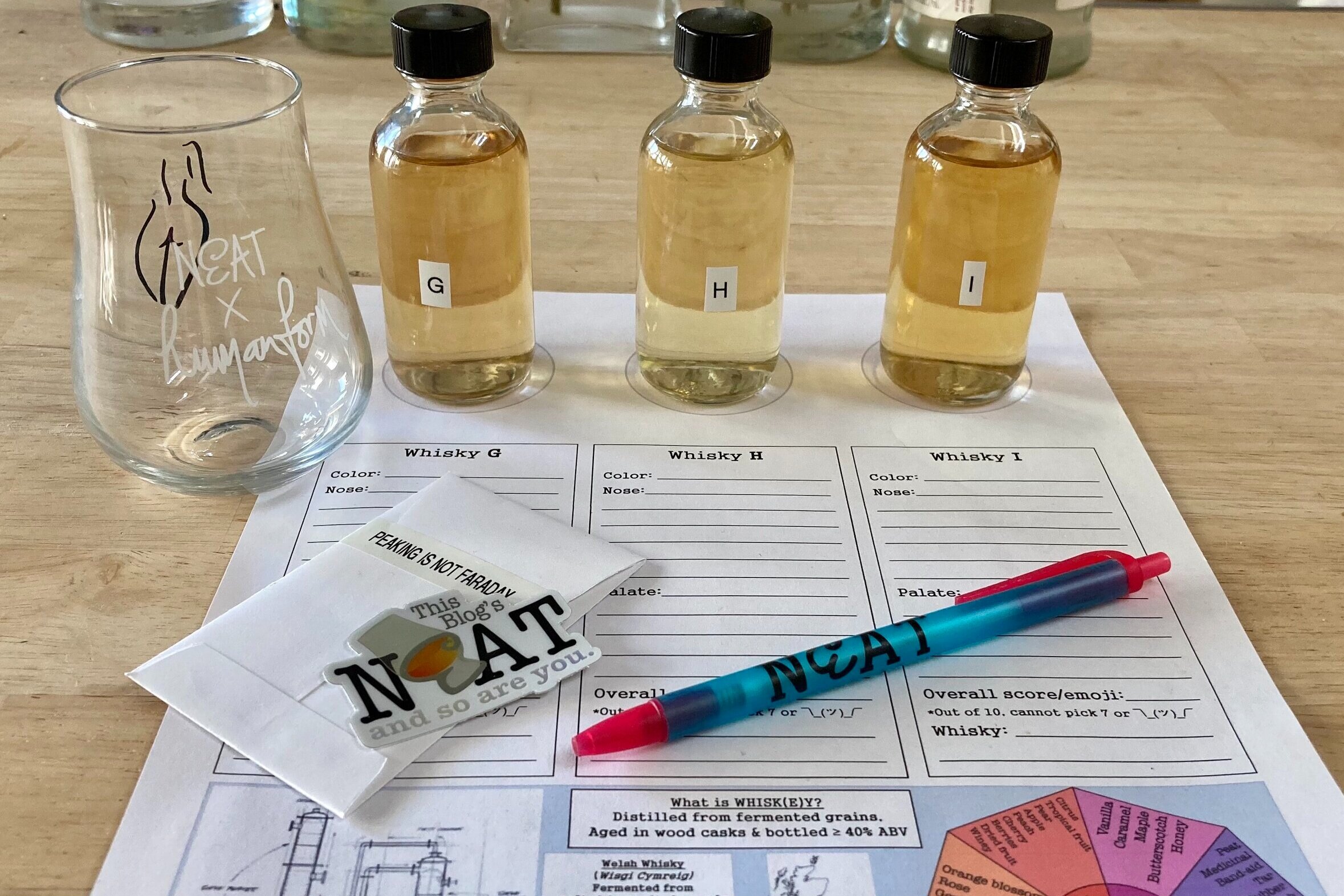Blind Tasting No. 5 Recap
Easy Peat
This weekend we focussed on Islay (pronounced eye-luh) single malt scotches! These whiskies are known for being smoky and this smokiness is derived from peat. And boy can it be polarizing. Peat-heads can’t get enough of the smoky scotch, while some people would never touch a whisky from the island for fear of the infamous peat reek. But not all Islay whiskies are in-your-face smoky and some aren’t smoky at all. The aim of this tasting was to prove that by easing the club members into peaty whiskies.
You might be saying, “who’s this peat guy you keep talking about?” Peat is decomposed organic matter that develops in wetlands, and on Islay it’s mostly composed of moss, seaweed and shrubs. It’s Scotland's native fuel source, so before the industrial revolution it was used for things like heating homes and kilning malted barley. During malting, peat is burned to provide the heat source needed for kilning. The phenols from the peat smoke stick to the barley (think about how the smell of smoke sticks to you after being next to a campfire) and this is what causes the whisky to taste smoky. Even though it’s no longer the necessary heat source for kilning, peat is still used today to create that traditional smokiness.
The peatiness of malted barley is measured in phenolic parts per million (ppm) and each distillery on Islay has their own specifications for their malt. These phenols are responsible for notes of smoke, bandaids, rubber, brine, meat, medicinal, spice, tobacco, floral, musty, coffee, leather, burnt, tar, asphalt, metallic, etc. The list goes on! But the influence of the peat is directly impacted by fermentation, maturation and especially distillation of the whisky. Fermentation and maturation will add flavors that balance the phenols, while distillation allows for the intricate selection of which phenols are present in the whisky. So it doesn’t just depend on the phenolic ppm measurement of the barley.
Now let's take a look at the distilleries on Islay!
Kildalton Trio
Ardbeg, Laphroaig and Lagavulin are known as the Kildalton Trio and they produce notoriously smoky whiskies. Ardbeg tends to have lighter whiskies with notes of soot, seaweed and citrus that comes from long fermentations, having a reflux on their spirit still and aging mostly in ex-bourbon barrels. Laphroaig on the other hand would never be described as light. Their whiskies are full of tarry, medicinal and smoky notes because of the cold smoked peat used for their malting, the large heads cut and low hearts cut (60% ABV) they take. Lagavulin produces whiskies with bonfire, iodine and sweet notes that come from their slow distillation speed, large distillation cuts and sherry barrel influence during aging.
East Coast
If we move over to the east coast of Islay, we get the two largest distilleries on the island: Caol Ila and Bunnahabhain. Caol Ila’s whisky is primarily used in blends, however their single malt is known for being grassy, salty and smoky. Interestingly, Caol Ila and Lagavulin use the same peated malt that’s sourced from Port Ellen, yet they taste very different. This is due to the tall stills at Caol Ila and their specific distillation cuts that produce a lighter spirit. Bunnahabhain stopped producing peaty whiskies in the 1960s when the demand for smoky scotch dropped, however they have been revisiting peat once again. They are known for sweet whiskies with the lowest peat levels on average, balanced with notes of dried fruit. This is because of their tall stills (the tallest on Islay) and their use of sherry butts for maturation in traditional dunnages, which imparts fruity flavors and a coastal influence.
West and Central
Last but not least, Bruichladdich, Bowmore and Kilchoman are on the west and central part of Islay. Bruichladdich produces a wide range of whiskies, some are unpeated (Bruichladdich label), others are heavily peated (Port Charlotte label) and a few are the peatiest scotches ever released (Octomore label). They are known for creamy, honey whiskies with a varied peat influence and they focus on the flavors that come from using different types of barley. Their tall stills produce a more refined, lighter spirit. Bowmore would not be described as light, but rather their whiskies have the quintessential peat reek (like pure smoke) balanced with some funky tropical fruit notes. This comes from the distillation cuts they take using their relatively average sized stills, not producing a light nor heavy spirit. They age their whiskies in both ex-bourbon and sherry barrels and are famous for their below sea level dunnage, Vault No. 1. The newest distillery on the island, Kilchoman, is known for producing whiskies with sweet cereal, brine and herbal notes. Kilchoman grows and malts their own barley, does long fermentations to build up lactic acid and esters (creaminess and fruitiness), and has a reflux on their spirit still. They then age in ex-bourbon barrels and some oloroso casks.
Now that I’ve told you about each distillery, Islay tell you how the tasting went (...get it?).
As you know, this was a blind tasting. The bottles were labelled M, N and O and only I knew which distilleries were featured. What stood out most to everyone while tasting whisky M was dried fruits, like dark cherry and dried apricot, with creaminess, vanilla and some brine. M was the crowd favorite! As we moved onto whisky N, notes of campfire, leather, soot, seaweed and salt were balanced by some citrus. Finally, whisky O tasted the lightest of the three with vegetal and herbal notes combined with fresh tennis ball/bike tire, brine and salt. O became one of our members new favorite whiskies!
This tasting was very challenging. For some, this was their first time embarking on a peaty adventure, while others are peat-heads. However, no one guessed 3-for-3 correctly! Nevertheless, I’m constantly amazed by how everyone’s palates are developing!











